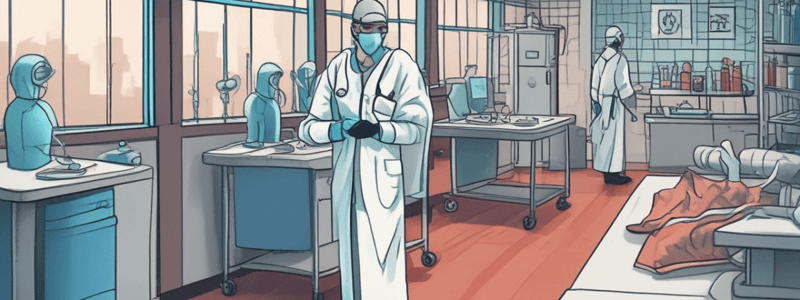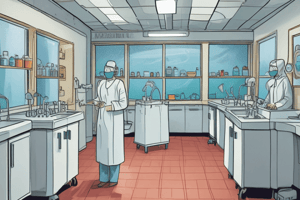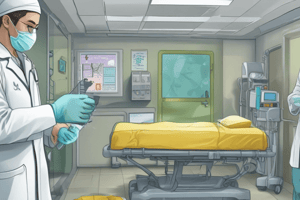Podcast
Questions and Answers
What is the primary means of transferring microorganisms from contaminated environmental surfaces to patients?
What is the primary means of transferring microorganisms from contaminated environmental surfaces to patients?
- Airborne transmission
- Contaminated equipment
- Personnel hand contact (correct)
- Direct patient contact
What is the primary benefit of removing unnecessary items from the dental procedure area?
What is the primary benefit of removing unnecessary items from the dental procedure area?
- Reducing the risk of transmission of infectious agents
- Increasing the efficiency of the treatment session
- Minimizing the need for additional instruments
- Facilitating a thorough cleaning following each patient (correct)
What is the advantage of using disposable items in dental procedures?
What is the advantage of using disposable items in dental procedures?
- Increasing the efficiency of the treatment session
- Reducing the risk of transmission of infectious agents
- Solving the problem of proper reprocessing (correct)
- Minimizing the need for sterilization
What is the purpose of prearranging tray set-ups for routine or frequently performed procedures?
What is the purpose of prearranging tray set-ups for routine or frequently performed procedures?
What is the advantage of using individualized, sterilized bur blocks for each procedure?
What is the advantage of using individualized, sterilized bur blocks for each procedure?
Why should a rubber dam setup be included on the tray setup if it will be used during a clinical procedure?
Why should a rubber dam setup be included on the tray setup if it will be used during a clinical procedure?
What is the primary purpose of using surface barriers in a dental procedure area?
What is the primary purpose of using surface barriers in a dental procedure area?
What should be done with patient records once treatment has begun?
What should be done with patient records once treatment has begun?
What is an essential pretreatment procedure for personnel involved in patient care?
What is an essential pretreatment procedure for personnel involved in patient care?
What should be considered when preparing the dental procedure area prior to beginning a clinical procedure?
What should be considered when preparing the dental procedure area prior to beginning a clinical procedure?
Why are surface barriers resistant to fluids?
Why are surface barriers resistant to fluids?
What is the primary goal of infection control procedures during the treatment period?
What is the primary goal of infection control procedures during the treatment period?
What is a crucial step in infection control during the post-treatment period?
What is a crucial step in infection control during the post-treatment period?
What is the primary purpose of using a rubber dam during dental treatment?
What is the primary purpose of using a rubber dam during dental treatment?
Why is it essential to avoid touching unprotected switches, handles, and equipment once gloves have been contaminated?
Why is it essential to avoid touching unprotected switches, handles, and equipment once gloves have been contaminated?
What should be removed after treatment to prevent the spread of infection?
What should be removed after treatment to prevent the spread of infection?
What is a critical component of an effective infection control program?
What is a critical component of an effective infection control program?
What is a key finding from laboratory studies regarding microorganisms on environmental surfaces?
What is a key finding from laboratory studies regarding microorganisms on environmental surfaces?
What is the main reason why infection control is necessary in dentistry?
What is the main reason why infection control is necessary in dentistry?
Who is responsible for implementing infection control protocols in the dental office?
Who is responsible for implementing infection control protocols in the dental office?
What is one of the modes of diseases transmission in dentistry?
What is one of the modes of diseases transmission in dentistry?
What is the objective of infection control in dentistry?
What is the objective of infection control in dentistry?
What should be done to prevent the transmission of disease in the dental office?
What should be done to prevent the transmission of disease in the dental office?
What is the chain of transmission of infection in dentistry?
What is the chain of transmission of infection in dentistry?
Why is it important to follow infection control protocols in the dental office?
Why is it important to follow infection control protocols in the dental office?
Flashcards
Infection Control in Dentistry
Infection Control in Dentistry
Preventing the spread of infectious agents during patient care.
Direct Contact Transmission
Direct Contact Transmission
Contact with infected blood or body fluids.
Indirect Contact Transmission
Indirect Contact Transmission
Touching a contaminated surface or instrument.
Droplet Transmission
Droplet Transmission
Signup and view all the flashcards
Infectious Agent
Infectious Agent
Signup and view all the flashcards
Susceptible Host
Susceptible Host
Signup and view all the flashcards
Reservoir
Reservoir
Signup and view all the flashcards
Portal of Entry
Portal of Entry
Signup and view all the flashcards
Portal of Exit
Portal of Exit
Signup and view all the flashcards
Means of Transmission
Means of Transmission
Signup and view all the flashcards
Objectives of Infection Control
Objectives of Infection Control
Signup and view all the flashcards
Infection Control Measures
Infection Control Measures
Signup and view all the flashcards
Reduce Transmission
Reduce Transmission
Signup and view all the flashcards
Simplify Cleaning and Disinfection
Simplify Cleaning and Disinfection
Signup and view all the flashcards
Importance of Infection Control: Why
Importance of Infection Control: Why
Signup and view all the flashcards
Importance of Infection Control: Who
Importance of Infection Control: Who
Signup and view all the flashcards
Importance of Infection Control: What
Importance of Infection Control: What
Signup and view all the flashcards
Infection Control: Pretreatment
Infection Control: Pretreatment
Signup and view all the flashcards
Infection Control: Treatment - Sharp Instruments
Infection Control: Treatment - Sharp Instruments
Signup and view all the flashcards
Infection Control: Treatment - Equipment
Infection Control: Treatment - Equipment
Signup and view all the flashcards
Infection Control: Treatment - Syringes/Needles
Infection Control: Treatment - Syringes/Needles
Signup and view all the flashcards
Infection Control: Treatment - Rubber Dam
Infection Control: Treatment - Rubber Dam
Signup and view all the flashcards
Infection Control: Post-Treatment
Infection Control: Post-Treatment
Signup and view all the flashcards
Infection Control: Post-Treatment - Barriers
Infection Control: Post-Treatment - Barriers
Signup and view all the flashcards
Infection Control: Post-Treatment - Reuse
Infection Control: Post-Treatment - Reuse
Signup and view all the flashcards
Infection Control: Post-Treatment - Treatment Room
Infection Control: Post-Treatment - Treatment Room
Signup and view all the flashcards
Infection Control: Surface Contamination
Infection Control: Surface Contamination
Signup and view all the flashcards
Infection Control: Hands and Surfaces
Infection Control: Hands and Surfaces
Signup and view all the flashcards
Infection Control: Personal Protective Equipment (PPE)
Infection Control: Personal Protective Equipment (PPE)
Signup and view all the flashcards
Levels of Disinfection
Levels of Disinfection
Signup and view all the flashcards
Sterilization
Sterilization
Signup and view all the flashcards
Disinfection
Disinfection
Signup and view all the flashcards
Study Notes
Infection Control in Dentistry
- Infection control is crucial in dentistry to reduce the risk of transmission of infectious agents during patient care.
Modes of Disease Transmission
- Direct contact with blood or body fluids
- Indirect contact with a contaminated instrument or surface
- Contact of mucosa of the eyes, nose, or mouth with droplets or spatter
Chain of Infection
- Infectious agent
- Susceptible host
- Reservoirs
- Portal of entry
- Portal of exit
- Means of transmission
Objectives of Infection Control
- Protect patients and dental staff
- Implement infection control measures
- Reduce the risk of transmission of infectious agents
- Simplify cleaning and disinfection procedures
Importance of Infection Control
- Why: Dental staff and patients may be exposed to a wide variety of pathogenic microorganisms
- Who: Each member of the dental team must follow recommended guidelines
- What: Prevent the transmission of disease in the dental office
Infection Control during the Pretreatment Period
- Remove unnecessary items from the dental procedure area
- Preplan the materials needed during treatment
- Utilize disposable items whenever possible
- Use prearranged tray set-ups for routine or frequently performed procedures
- Use individualized, sterilized bur blocks for each procedure
- Identify items that will become contaminated during treatment
- Review patient records before initiating treatment and place radiographs on the view box
- Prepare personnel involved in patient care
Infection Control during the Treatment Period
- Use care when receiving, handling, or passing sharp instruments
- Avoid touching unprotected switches, handles, and other equipment once gloves have been contaminated
- Avoid entering cabinets once gloves have been contaminated
- Take special precautions with syringes and needles
- Use a rubber dam whenever possible
Infection Control during the Post-Treatment Period
- Continue to wear personal protective equipment during clean-up
- Remove all disposable barriers
- Clean and disinfect all items not protected by barriers
- Cleaning and disinfection of the dental treatment room surfaces are important components in an effective infection control program
- Microorganisms may survive on environmental surfaces for a long time
- Transfer of microorganisms from contaminated environmental surfaces to patients occurs primarily through personnel hand contact
Studying That Suits You
Use AI to generate personalized quizzes and flashcards to suit your learning preferences.




